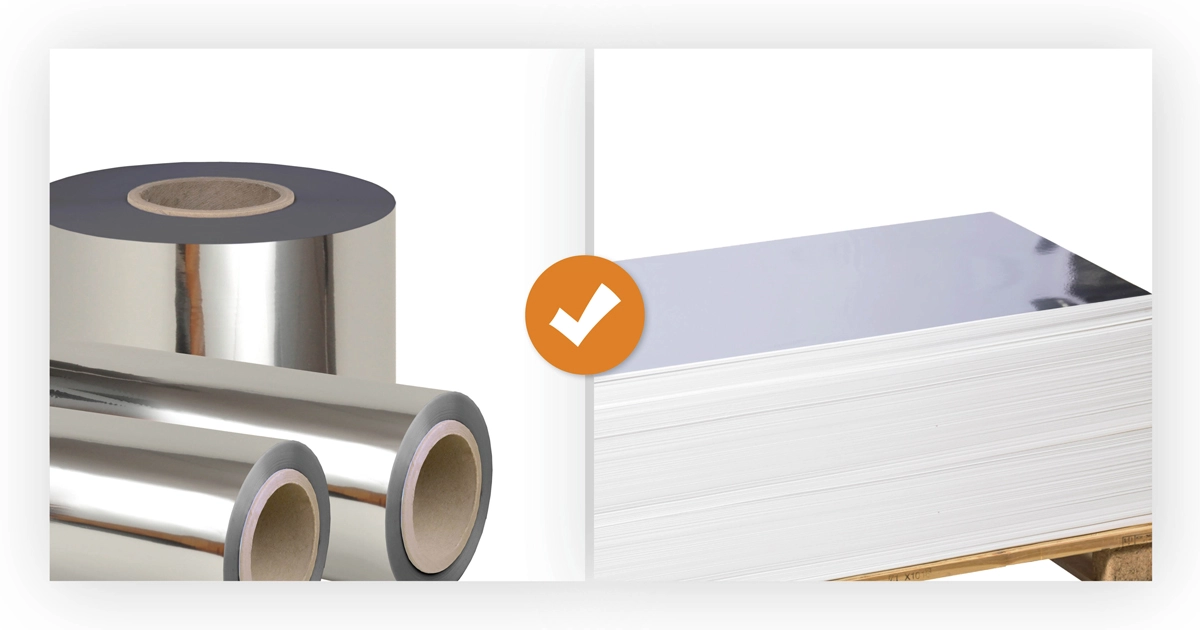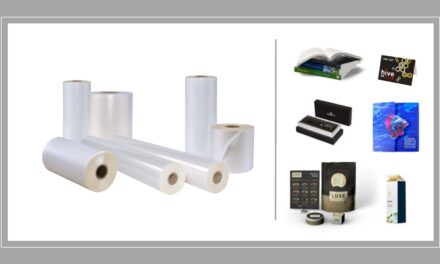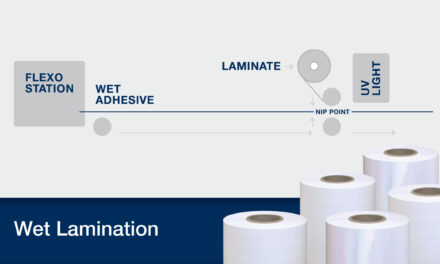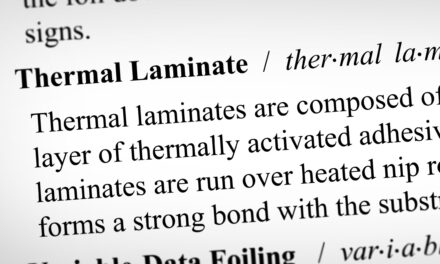CREATIVE SOLUTIONS, BIGGER REWARDS
In the print and packaging industry, each step in the supply chain counts. Everything from material sourcing and transportation to the processing of these materials into usable goods has an effect on the bottom lines of the printers, brands, and consumers who utilize them. While it is impossible to eliminate all the middlemen involved in the creation of a package, modern print service providers are coming up with creative ways to streamline the packaging creation process, especially when it comes to foil board.
Historically, foil board has been produced by a manufacturer and then sold to printers who need it to create folding cartons, rigid boxes, trading cards, and a wide variety of other applications. However, it is becoming increasingly more common for printers to bring foil board manufacturing in-house utilizing the materials and equipment they already have, resulting in a significant return on investment for the printer and their own customers alike.
HOW TO PRODUCE METALIZED FOIL BOARD IN-HOUSE
Metalized foil board production is a fairly simple process: board stock is overlaid with a metallic foil layer to create a shiny, printable surface that can receive other embellishments to create stunning, unique designs on a variety of packaging types. This layer can also provide additional protection from moisture, dirt, and grease to ensure frequently handled items stay in good condition.
To bring this process in-house, printers will need three key things: metalized thermal laminates, the appropriate board stock for each application, and a thermal laminating system with hot knife or flying knife separation to bring the two together. Production thermal laminating systems, such as those in the Nobelus portfolio, are more than capable of keeping up with the demands of the highest volume orders.
To create foil board, the metalized laminate roll is simply loaded onto the laminator while the board stock is placed in the feeder. The process is as simple and quick as any other form of thermal lamination, although printers will need to invest in equipment capable of separating sheets laminated with PET, which is more durable than BOPP and incompatible with bursting separation.
Afterwards, the foil board can be overprinted and then laminated with a transparent specialty laminate to bring another interesting element to the package, such as a soft-touch finish or a faux leather pattern.
TOP 4 BENEFITS OF INSOURCING METALIZED FOIL BOARD
Now that we have seen how easy the foil board production process is, let’s take a look at four key reasons insourcing metalized foil board production can be a wise move for many printing operations.
1. Cost Savings
Perhaps the most obvious benefit of in-house foil board production is the associated cost savings. While printers who currently outsource all their laminating needs may have to make an initial investment to install a thermal laminating system, the investment pays off quickly. By creating your own foil board, you gain the ability to purchase board stock and metalized laminates at the best price rather than defaulting to whatever products your previous vendor offered.
As service providers in any industry know, the prices of products include the cost of labor. By insourcing foil board production, you can eliminate the cost of outsourced labor and instead utilize the time of employees in your own facility. This increases profit margins on nearly any products that use metalized foil board. Additionally, transportation costs are reduced by paying for materials to be delivered directly to your facility instead of going to a middleman before being shipped a second time.
Insourced foil board production also allows printers to create exactly as much foil board as they need on demand. This means you no longer need to reach a minimum order quantity when a given order may use only a fraction of the amount. Ultimately, printers who insource foil board pay for materials, equipment, and energy while eliminating added costs from outsourced labor, shipping fees, processing fees, and more.
2. Shorter Lead Times
In many cases, the deciding factor in whether or not a printer gets a specific brand’s business is speed to market, and few things help shorten lead times as much as bringing simple processes in-house. By keeping the necessary materials in stock and replacing them with each job, printers can assure prospective customers that they will never have unexpected delays when it comes to folding cartons or other metallic packaging.
Printers can also advertise their ability to fulfill orders with short turnarounds, such as situations where the brand’s usual print service provider falls through or extra orders are needed as soon as possible. Offering in-house foil board production can help printers position themselves as a vendor who is reliable and in full control of their production.
3. Less Material Waste
Perhaps unexpectedly, insourcing foil board can have a positive impact on the environment compared to outsourcing. Printers no longer need to meet minimum order quantities even if they do not plan to use all of the foil board that comes in. On-demand foil board production helps ensure that no sheet is wasted even if incoming orders are sporadic or unpredictable.
Because metalized laminates are usually opaque and completely hide the substrate, scrap paper and misprints can be used in place of clean sheets. This helps printers recoup losses from errors in production in addition to keeping paper out of the landfill or recycling stream until it has served its intended purpose.
4. Greater Control Over Quality
Finally, printers who bring foil board production in-house instantly achieve better control over the quality of the board and therefore the finished package. Every foil board manufacturer should have a quality control team whose responsibility is to ensure each sheet that is shipped out is free of streaks, peeling, bubbles, and other defects. However, if a poor-quality batch slips through their systems, it can take days if not weeks to discover the issue, report it to the manufacturer, allow time for troubleshooting, and finally receive the quality foil board that should have been delivered from the start.
By bringing this process in-house, printers can not only verify immediately that the foil board is in good condition but also quickly identify where issues stem from in the lamination process when defects do appear. It can be frustrating to be caught in the middle between a struggling manufacturer and an unhappy, impatient customer; printers who take control of their processes by bringing them in-house can take full responsibility for the quality of their products and service instead of being caught in an endless quality control and troubleshooting cycle.
WANT TO LEARN MORE ABOUT METALIZED FOIL BOARD?
If you want to learn more about specific products or equipment that can help you bring foil board production in-house, please don’t hesitate to reach out to a Nobelus representative by phone or email. Our sales representatives can help you identify which products would be best for your needs, and our strategic solutions specialists can walk you through the process if you are new to lamination. We have a team of trained in-house technicians who can install a thermal laminating system in your facility and answer any questions you may have.





